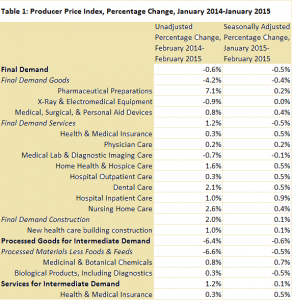Health Goods Prices Rise; Other Prices Fall
Last Friday’s release of the Producer Price Index for February confirms that prices for health goods and services are rising at a much higher rate than other producer prices, most of which are declining significantly.
As shown in Table 1, prices of goods for final demand actually dropped 4.2 percent over the last twelve months. However, prices of pharmaceutical preparations increased by 7.1 percent; and prices of medical, surgical, and personal-aid devices also crept up.
Prices for intermediate goods tell a similar story, with prices for medicinal, botanical, and biological chemicals experiencing higher price growth than other processed chemicals.
Prices for services sends a much less clear signal, being distributed around an increase of 1.2 percent for all demand services. (Health insurance is categorized as both a final and intermediate services, as it is sold both retail and wholesale.)
Prices of services are more important than prices of goods in determining overall health price inflation. Nevertheless, there is no evidence that Obamacare is holding down prices of health services.
(The Altarum Institute has also released its updates of health spending and prices, which show strong growth in health spending of 5 percent in 2014 and high relative price inflation.)



For the past 50 years, the price of medical care has been rising at nearly three times the rate of inflation. By contrast, the price of cosmetic surgery procedures have been rising at about the same rate as inflation. The former is bureaucratic, and relies on third-party payment for 89% of bills. The latter is not covered by insurance; cosmetic surgeons must compete with transparent pricing and generally offer package deals. In many cases, the same doctors who work in bureaucratic medicine also dabble in cosmetic medicine. Go figure!